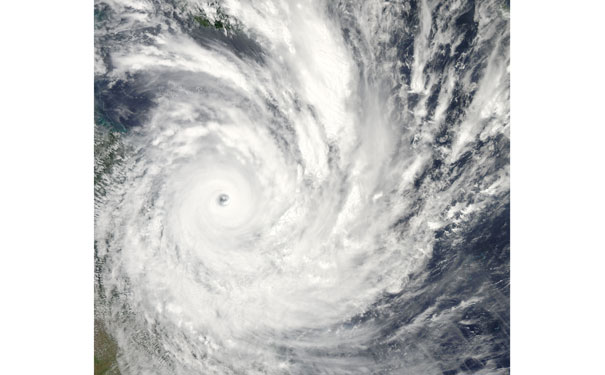
Cyclone Yasi approaching the coast at 1:35 p.m. Australian EST on February 2nd. NASA image courtesy Jeff Schmaltz
Climate change has been blamed for increased cyclone activity, but has there been any change at all?
Global temperature has warmed by nearly a degree over the last century, which should have had a big impact on cyclone activity. Professor Neville Nichols from Monash University says “there’s no doubt that global warming must affect cyclones.”
The current La Nina conditions are conducive for cyclone formation as a result of the warmer sea surface temperatures (SSTs) associated with La Nina events. “During a La Nina event you tend to get more tropical cyclone events around Australia than normal.” Professor Nicholls explains.
“In an El Nino you get exactly the opposite.”
Cyclones form over waters that are warmer than 26 degrees celsius in an area of low pressure. There are concerns that the predicted increase in global temperature may cause more frequent, stronger cyclones in the future.
But Professor Nichols says scientists can’t tell us how this temperature change is influencing cyclone activity. “We can’t tell you what that impact is- it doesn’t seem to be making more tropical cyclones for instance.”
There is a consensus among scientists who study cyclones around the world that there hasn’t been an increase in cyclone strength or activity. Something else is happening to offset the increase in tropical cyclone activity that could be explained by the warmer SSTs, but because they haven’t seen more tropical cyclones, scientists aren’t confident in predicting the effect of global warming on these events.
There is also a debate over whether the El Nino/ La Nina cycle could be intensified and affect the behaviour of cyclones. However, scientists are uncertain if stronger La Nina or El Nino events cause stronger cyclones. There is also no obvious evidence of how El Nino/La Nina have been affected by climate change.
According to Professor Nicholls, it’s hard to predict the changes because there isn’t enough data and scientists need better models of El Nino/ La Nina and cyclones themselves. We need to take the best information we have on how they work, blend this with the fact that the world is warming and see what happens, he says.
For example, El Nino and La Nina could getter hotter and there would be more moisture during La Nina). According to Professor Nicholls we’re undergoing a warmer La Nina, but it is a natural event. “Climate change adds this other twist.”






